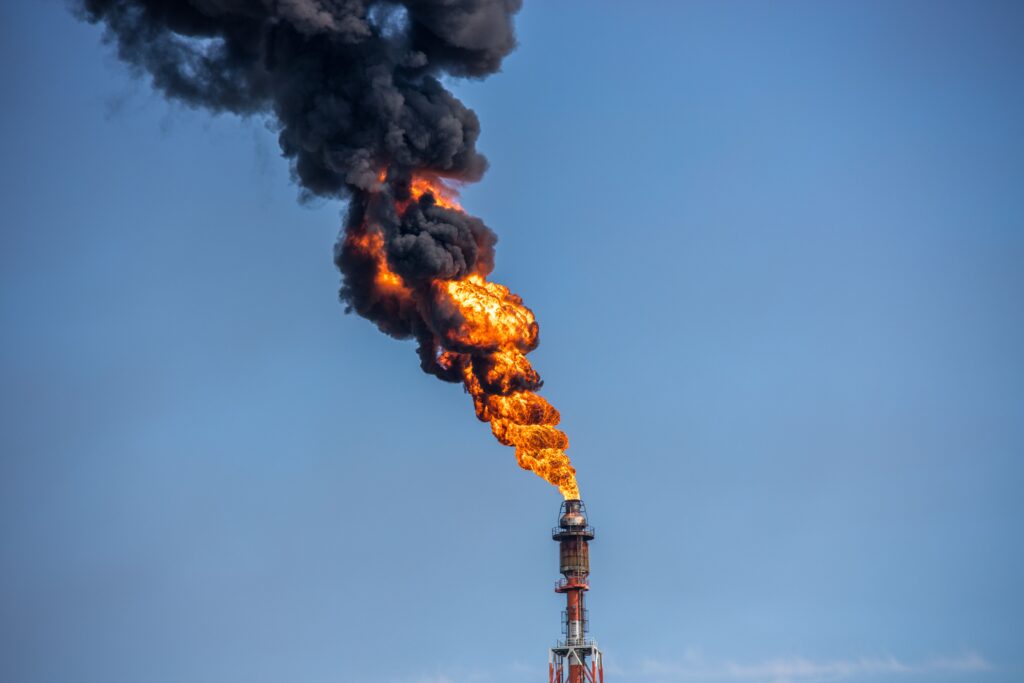See what we do
De-Flaring in the Niger Delta
The practice of gas flaring, which involves the combustion of excess natural gas at oil extraction sites, presents notable business opportunities. By capturing and utilizing this otherwise wasted and polluting flared gas, TWD Energy will convert it into a valuable energy resources. This process not only facilitates the generation of cleaner energy and other useful products but also creates multiple revenue streams and value chains, enhancing both economic and environmental outcomes.
De-Flaring Nigeria
for a Cleaner Energy Future
The Nigerian government is committed to achieving zero routine flaring by 2060 and universal energy access by 2060. TWD Energy stands ready to make this promise a reality with the Bayelsa LNG Project.
Did you know…?
Nigeria has a short-term vision for the year 2030 called
30:30:30. The target is to attain 30GW of grid energy supply with a 30 percent Renewable Energy mix by 2030, with a long-term goal of universal energy access.
Our purpose
On a Mission Towards Cleaner Energy...

No More Wasted Flare Gas
Natural gas flaring in Nigeria contributes about 1 percent to global CO2 emissions, which has serious environmental consequences.
In the first six months of 2024, natural gas estimated at $520.2 million dollars and capable of powering four million households was flared in Nigeria according to data obtained from the Nigerian gas flare tracker of the National Oil Spill Detection and Response Agency (NOSDRA).
The amount lost to gas flaring in the first half of 2024 was 7.06 per cent higher than the $485.9 million lost to the activity in the same six-month period in 2023.
Better Health for us
Better Health for the Earth
Dangerous air pollutants are created when gases are flared. Contaminants from flared gas are are reported to cause cancer, nervous system and reproductive problems, skin issues, lung damage and birth defects among other concerns.
More than just air pollution
Over 2 million people in the Niger Delta reside within 2 miles of a gas flare. These flares generate significant noise, scorching heat and continuous light, making it seem that daylight never ends.

Local action,
global impact
The Bayelsa LNG Project will be the first of its kind in Nigeria. Its timing is particularly advantageous, aligning with the urgent need for cleaner energy solutions. By utilizing previously wasted gas, the project has the potential to significantly displace more polluting energy sources like coal, thereby contributing to a reduction in overall carbon emissions.
Moreover, the project is poised to enhance energy access and security in the region. By harnessing and processing flared gas into liquefied natural gas (LNG), it not only provides a cleaner alternative to traditional energy sources but also supports local energy infrastructure. This will improve energy reliability, bolster economic growth, and promote sustainable development across Nigeria.
Why do oil companies flare?
Fossil fuel (oil) companies flare gas when capturing the gas would cost more than they can make by selling it. It has been illegal to flare gas in Nigeria since 1984 without the written permission of the Minister of Petroleum Resources. However, the current penalties for gas flaring in Nigeria officially stand at just $2 per 1000 standard cubic feet. This has led to many of the companies who are flaring to opt for paying the penalty rather than investing in the long term solutions and infrastructure needed to capture the gas.
Flare gas as feed gas!
TWD Energy is breaking ground on de-flaring infrastructure that taps into wasted, stranded resources. Routinely flared natural gas is captured before it enters the atmosphere and converted to clean energy, saving the environment from methane and greenhouse gases. Methane, the primary component of natural gas, is a potent but short-lived greenhouse gas. The warming potential of methane is 82.5 times higher than carbon dioxide over a 20 year period.
Methane mitigation and emissions abatement
Reducing methane emissions addresses both climate change and provides the added benefits of improving air quality, protecting human health, and quality of life.
Methane plays a significant role in the formation of tropospheric ozone, also known as ground-level ozone, a harmful air pollutant associated with approximately one million deaths per year and the loss of up to 110 million tons of crops.
Partners in the Global Methane Initiative
At TWD Energy, we leverage human ingenuity to implement scalable solutions that provide low-carbon, sustainable LNG and natural gas products for both local use and global export.
Nigeria loses $1B in wasted flare gas every year
“The wasteful disposal of natural gas is not only fraught with deleterious health and environmental consequences but also a major source of resource waste and value erosion to the country.”
–Engr Gbenga Komolafe, Chief Executive,
The Nigerian Upstream Regulatory Petroleum Commission.
Nigeria, Africa’s largest oil producer, flares a significant amount of natural gas, which could otherwise help address the country’s energy shortages. In the first half of 2024, approximately 148.7 million standard cubic feet of gas were flared, according to the National Oil Spill Detection and Response Agency (NOSDRA). This flared gas has the potential to generate around 3,401.83 megawatts (MW) of electricity, which could power over 3.4 million homes, based on data from the Nigerian gas flare tracker and the U.S. Energy Information Administration, which estimates that one megawatt can supply electricity to 1,000 households.
The economic impact of flaring in Nigeria is substantial. The World Bank estimates that historically, Nigeria has incurred losses of around $72 billion between 1970 and 2006, translating to an average annual revenue loss of about $2.5 billion due to flaring, as the flared gas could have otherwise been sold or utilized for energy production.
In 2023, Nigeria flared about 275 million Mscf of gas annually at more than 160 flare sites, contributing to approximately 10 percent of global flaring. The flaring emitted approximately 14 million tons of CO2 equivalent per year.
The environmental damage and health impacts from flaring contribute to significant indirect costs, including increased healthcare expenses and loss of agricultural productivity. The economic losses from flaring not only hinder Nigeria’s energy development but also exacerbate the country’s socio-economic challenges.
Unlocking the Power of Flare Gas:
The Essential Energy Molecules
Shaping Our Future
CNG
Compressed natural gas (CNG) is an economical and widely accessible alternative fuel that offers significant environmental advantages. Primarily used to power vehicles, CNG is also versatile enough for other applications such as power generation, water heating, and air conditioning. Its use reduces greenhouse gas emissions compared to traditional fuels, contributing to a cleaner and more sustainable energy landscape.
LPG
Liquefied petroleum gas (LPG), commonly referred to as propane, is extracted from “wet” natural gas, which contains condensable heavy petroleum compounds, through an absorption process. LPG is user-friendly, non-toxic, and burns cleanly without emitting smoke, soot, or odors. It is widely utilized as fuel for gas cooktops, ovens, barbecue grills, gas fireplaces, and portable heaters. LPG stoves and burners are not only economical but also require less maintenance compared to other cooking methods. Additionally, LPG can be stored for extended periods without degradation, making it a durable and reliable energy source.
LNG
Liquefied natural gas (LNG) is considered the cleanest fossil fuel, as it generates lower carbon dioxide emissions compared to coal and oil. It also produces less soot, dust, and other harmful pollutants than these coal and oil. LNG is safe to store in its liquid state due to its non-flammable nature, and because it is lighter than air, it disperses rapidly if leaked, reducing the risk of soil or groundwater contamination. Common uses for LNG include cooking, heating, generating electricity, and manufacturing products like fertilizers, paints and medicines. Expanding LNG trading can enhance the global distribution of natural gas, thereby powering industries and supporting the energy needs of developing nations.
CH
4
- C1, Methane
- A chemical compound consisting of one carbon atom and four hydrogen atoms, the simplest alkane
- Accounts for about 91% of the flare gas composition
METHANE
Methane is found abundantly in nature and is formed by the decay of natural materials. Methane is the primary component of natural gas, which is widely used for heating, electricity production, automotive fuel (CNG) and rocket fuel. Methane is a highly efficient energy source, producing more heat and light per mass compared to other fossil fuels like coal and gasoline, while emitting significantly less carbon dioxide and pollutants that contribute to smog and poor air quality. Methane is used to manufacture organic chemicals and is a common ingredient in fertilizer and anti-freeze.
C
2
H
6
- C2, Ethane
- A chemical compound consisting of 2 carbon atoms and six hydrogen atoms belonging to the paraffin series
- Accounts for about 5.5% of the flare gas composition
ETHANE
Ethane is a colorless, odorless gaseous hydrocarbon and the second most significant component of natural gas. It is primarily used to produce ethylene, a key feedstock in producing plastics. One notable application is in the manufacture of polyvinyl chloride (PVC), which is utilized in construction, insulation, plumbing, siding, and flooring, particularly in sterile environments. Ethane is also used in the preparation of ethanol, acetaldehyde and acetic acid used in paints, varnishes, adhesive and plastic. Additionally, ethane is used as a refrigerant in cryogenic systems and is found in products such as antifreeze and detergents. It also plays a role in the production of welding gas.
C
3
H
8
- C3, Propane
- A three-carbon, eight hydrogen alkane gas that is colorless, odorless, and flammable
- Accounts for about .18% of the flare gas composition
PROPANE
Composed entirely of carbon and hydrogen, propane is also known as liquefied petroleum gas (LPG) or propane autogas. Propane is versatile and used for various applications including heating homes and water, drying clothes, cooking food, and powering standby generators. It can also fuel vehicle fleets such as school buses, taxis, and delivery vans. Stored under pressure as a liquid in tanks, propane vaporizes into a gas when the pressure is released. It is extracted from natural gas, light crude oil, and oil-refinery gases and is .14% of the flare gas.
C
2
H
10
- i-C4, Isobutane
- A four carbon, ten hydrogen isomer of butane that is colorless, odorless, and easily liquefied
- Accounts for about .14% of the flare gas composition
ISOBUTANE
Like other butanes, it is a highly flammable, colorless, and odorless gas that can be easily liquefied. It is commonly used as an additive in gasoline to enhance octane ratings, control volatility, and improve engine performance, particularly in cold weather to ensure easier starting and reduce pollution. In addition to its use in fuels, isobutane serves as a refrigerant in household refrigerators as well as a propellant in various aerosol products, including hairspray, deodorant, cleaning products, sunscreens, bug sprays, and lighters.




